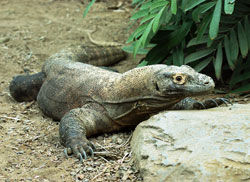Vacation / Travel Supplement
Largest lizard:
Two Komodo dragons live at Indianapolis Zoo this summer

The Komodo Dragon, the largest lizard in the world, can grow up to 10 feet long. The giant reptile is a predator, and produces virulent bacteria in its saliva that helps kill its prey. The dragon is an endangered species. (Submitted photos/courtesy Indianapolis Zoo)
By Mary Ann Wyand
In fairy tales, mythical dragons fly and “breathe” fire.
Komodo dragons, featured in the Indianapolis Zoo’s new summer exhibit, can’t fly and aren’t fire-breathing, but they are the world’s largest living lizards and their powerful bite is poisonous.
The endangered reptile that takes its name from Komodo Island in Indonesia can grow to be 10 feet long and weigh 200 pounds. Its tail is as long as its body.
The huge lizard has a long, forked, snakelike tongue as well as toxic saliva and 60 jagged teeth that are one-inch-long.
It swings its head from side to side while walking, and can kill large prey ranging from pigs and deer to water buffalo, which it can detect up to six miles away.
The dragon has a slow metabolism and eats by tearing large chunks of carrion flesh from an animal carcass, often consuming up to 80 percent of its body weight in one meal.
Not to worry though because zoo visitors can get a safe look at two Komodo dragons on loan from the Denver Zoo from Memorial Day through Labor Day. They will live in a special glass-walled exhibit in the Plains Biome of the zoo.
Richard Reams, a zoologist and the Deserts Biome manager, is excited about the opportunity to help care for Hudo and Dipsner, named for cities in Indonesia.
“As a person who loves reptiles and amphibians, it is fascinating to work with the largest lizard in the world,” Reams explained in a telephone interview.
“It’s a wonderful opportunity to have this beautiful lizard in captivity here at the
Indianapolis Zoo for the public to view as well. It’s a unique opportunity for people to see these animals.”
The dragons were born at the Denver Zoo, he said, and are accustomed to being cared for by zookeepers.
“They are predators and can be dangerous,” Reams said. “However, these two specimens are captive animals and are actually both docile. We work pretty closely with them.”
The dragons arrived in Indianapolis on March 15, he said, and are already acclimated to their temporary home.
“Right now, they’re doing pretty well,” Reams said. “They will stay on exhibit all day long this summer, and the public can view them through the glass.”
About 95 percent of all types of lizards are under two feet long and only a few kinds of amphibians grow to five or six feet, he explained, so the Komodo dragon is a unique animal in its family group.
“Visitors can get a good idea of how big a Komodo dragon is then compare it to the lizard counterparts in the zoo’s Deserts Biome,” Reams said. “The Deserts building is full of various lizards and reptiles. Visitors can also get a good look at the Grand Cayman Blue Iguana, which is an endangered species of iguana that we breed here, and the bearded dragons, a smaller species of lizard.”
Children who like frogs, toads, snakes and chameleons will love watching the giant lizards, he said, because they are such unusual and amazing creatures.
(“Dragons of Komodo” is free for Indianapolis Zoo members and is included with the zoo’s regular admission fee. For more information, call 317-630-2001 or log on to www.indianapoliszoo.com.) †
